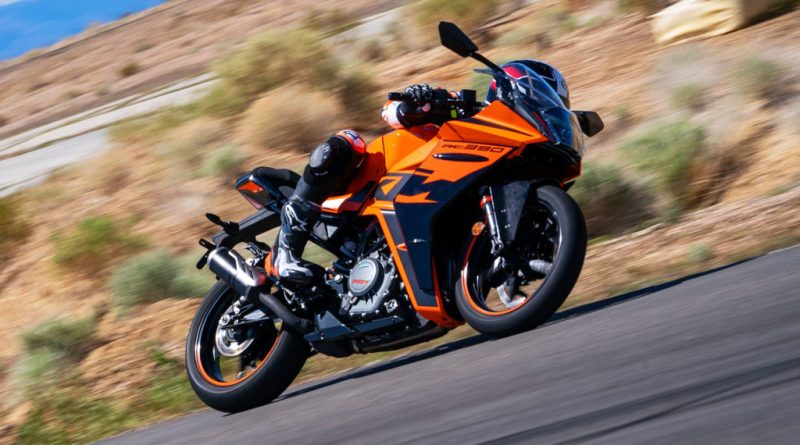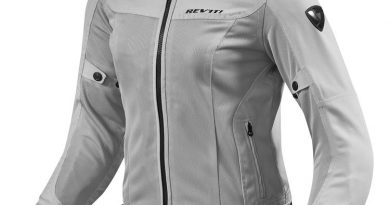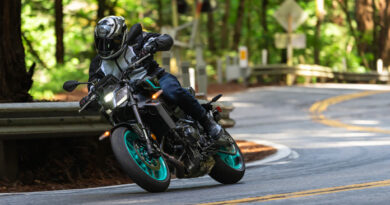2022 KTM RC 390 | First Ride Review
Updated for 2022, the KTM RC 390 sportbike is lighter and features standard cornering ABS and traction control. Photos courtesy of KTM.
Motorcycle manufacturers build entry-level sportbikes on a budget. That means high-tech luxuries like traction control and cornering ABS usually go out the window. Some would argue that small-bore supersports don’t generate enough power for such rider aids. On the other hand, newer riders could benefit most from the latest electronic safety nets. That’s the case with the 2022 KTM RC 390, which crashes the entry-level sportbike party with IMU-based tech.
Check out Rider’s 2022 Motorcycle Buyers Guide
The original KTM RC 390 burst onto the scene back in 2014, powered by a liquid-cooled 345cc Single with DOHC, four valves, and fuel injection. It made a claimed 44 horsepower at 9,500 rpm and 26 lb-ft of torque at 7,250 rpm. An update in 2017 bumped displacement up to 373cc and added throttle-by-wire and a slip/assist clutch.
The 2022 KTM RC 390 has all-new bodywork that’s easier to remove and wears race-inspired livery.
The 2022 model builds on those foundations and takes a big leap forward. The updated RC 390 gains lean-sensitive traction control, Bosch 9.1MP cornering ABS with two modes, and a full-color TFT display. The electronic suite is just the tip of the iceberg. KTM pairs the smarter tech with a significant reduction in weight and race-worthy WP Apex suspension. The RC 390 also delivers on KTM’s “Ready to Race” rallying cry with MotoGP-inspired livery, easily removable bodywork, clip-on handlebars, and a bolt-on subframe.
KTM made each revision in the name of faster lap times, so it was only appropriate to put the 2022 RC 390 through its paces at California’s Streets of Willow racetrack. The course’s tight, technical layout poses challenges for sportbikes of all sizes, but the RC 390’s balanced package proves that it’s poised to take on the competition.
A larger 3.6-gal fuel tank provides more contact area, making it easier to hang off in corners.
SUM OF ITS PARTS
KTM engineers didn’t just put the 2022 RC 390 on a diet plan, they shed pounds where it matters most. New cast wheels are 7.5 lbs lighter, and new ByBre brakes save another 2.1 lbs – reducing unsprung weight by nearly 10 lbs. Above the suspenders, KTM trimmed the fat from the steel trellis frame, saving another 3.3 lbs. A 1-gal. increase in fuel capacity (from 2.6 to 3.6 gals.) adds a few lbs, but claimed wet weight is just 324 lbs.
The RC 390’s strategic weight loss has made the light, agile bike even more light and agile. The RC changes direction with the slightest input yet remains true to its line. From the effortless tip-in to the apex-clipping accuracy, the 390 urges riders to carry more corner speed with each lap. Of course, extra agility can also compromise stability, but the RC stays steady on the brakes, on the straights, and at lean.
Adjustable WP Apex suspension and radial-mount ByBre front calipers are well-suited for aggressive sport riding.
Dustin’s Gear:
Helmet: Arai Defiant-X
Race Suit: Alpinestars Missile Ignition
Gloves: Alpinestars GP Pro R3
Boots: Alpinestars Supertech R
Only the high desert’s blustery conditions challenged the RC 390’s sure-footed nature. Crosswinds frequently pushed the pint-sized sportbike to the edge of the track, but riders can neutralize the effect with body postion. At one particular braking zone, the gusts hit the RC’s flank at a three-quarter angle and unsettled the chassis just before tip-in. However, the sub-400cc supersport recovered admirably, completing the turn without further protest.
The KTM remains composed thanks to its up-spec WP suspension. The 43mm WP Apex inverted fork may not offer preload adjustment, but 30 clicks of compression and rebound adjustment make it one of the most advanced offerings in the class. A preload- and rebound-adjustable WP Apex shock settles the rear, and KTM staff was on hand to fine-tune the settings for each rider’s individual style. Luckily, the standard setup wasn’t far off for me, and the track environment certainly showcased the suspension’s flexibility.
KTM’s PowerParts accessory catalog includes numerous upgrades, including WP Apex Pro suspension and an Akrapovič exhaust.
While we didn’t take to the streets on the 2022 RC 390, the WP suspension also allows users to stiffen the chassis for the raceway or dial up the comfort for the roadway. The Continental ContiRoad tires are classified as sport-touring tires, but their silica-rich compound provided more than enough feel and grip for aggressive track riding. Owners can easily swap the road-oriented rubber for stickier tires, but the ContiRoad’s versatility and longevity will suit everyday street riding as well as occasional track days.
FIGHT IN THE DOG
Euro 5 emissions regulations forced KTM to shrink the RC 390’s carbon footprint, but it also seized the opportunity to equip the 373cc Single with a 40% larger airbox and an updated fuel map. The four-valve thumper still churns out 44 horsepower, but engine tweaks squeezed out a tad more torque, raised the claimed peak from 26 to 27.3 lb-ft.
The KTM RC 390 is powered by a 373cc Single that makes 44 hp and 27.3 lb-ft of torque.
The small bump in torque boost isn’t discernible from the saddle, but the small-displacement Single still punches above its class. From cruising down pit lane to pinning the throttle on the home straight, the Bosch Engine Management System (EMS) and throttle-by-wire deliver predictable power and throttle response. The engine offers a decent amount of torque throughout the rev range, but with horsepower peaking just 500 rpm below the 10,000-rpm redline, extracting every ounce of performance can be a balancing act.
The RC 390’s approachable power profile adapts well to life on the street and the circuit, but the short gearing presented challenges at the track. Approaching one uphill section, I frequently found myself between 3rd and 4th gear. Staying in 3rd sacrificed speed on approach but maximized drive out of the corner. Conversely, shifting up to 4th optimized crucial uphill momentum but compromised corner-exit speed.
The optional up/down Quickshifter+ facilitates easy clutchless gear changes.
I solved the gearbox conundrum by the end of the track day, but riders will benefit from prioritizing gear management. As expected, KTM prepares the transmission for both the road and the track, but dedicated racers can adapt the gearing to personal preferences and differing courses with accessories from KTM’s PowerParts catalog.
SAFETY SIMPLIFIED
The optional Quickshifter+ ($180) is a must-have for avid track riders and racers. Thanks to the bi-directional function, upshifts on the straights and downshifts in the braking zone are simplified. The quickshifter provides smooth engagement in the higher gears and upper rev range, while shifts in lower gears and engine speeds require a bit of coordination. I did experience a couple of false neutrals, but they were the result of less-than-committed shifts.
The sub-400cc thumper doesn’t require much taming, but cornering ABS and MTC (Motorcycle Traction Control) make the RC 390 even more forgiving. The systems don’t limit or interfere with aggressive riding, and they increase the margin of safety should a rider apply too much throttle or brake while leaned over in a corner. A Supermoto ABS mode allows the system to be deactivated at the rear wheel.
A full-color TFT display makes it easy to navigate the RC 390’s various settings and information.
Thanks to the RC 390’s new full-color TFT display and simple menu system, riders have easy access to all the information they need and can adjust settings quickly.
LOOKING THE PART
With the 2022 KTM 890 Duke R and 2022 KTM 1290 Super Duke R Evo donning Red Bull KTM-inspired liveries, it was time for the RC 390 to get in on the action. Both 2022 color schemes leverage graphic designs from the KTM Factory team and Tech3 satellite team. The changes are more than skin-deep, though.
New graphics are inspired by KTM’s racebikes.
The redesigned fairing not only improves wind protection, its dual-layer panels also shuttle engine heat away from the rider. For dedicated track riders, KTM designers reduced the number of bodywork fasteners and installed a two-piece cockpit for easy headlight removal. Those preparations ease the process of swapping street-legal panels for race fairings.
Thanks to the RC 390’s narrower waist and larger 3.6-gal. tank, side-to-side transitions are fluid yet stable. Hanging off is easier than before, with the rider’s knees bracing against the fuel tank’s increased contact area. The new clip-ons also offer 10mm of adjustability for road-going comfort or a track-worthy stance. A sculpted seat shape amplifies the rider’s range of movement while the thicker foam suits street riding.
The 2022 KTM RC 390 has a compact cockpit, and the redesigned fairing and windscreen create a smooth bubble at full tuck.
As small-bore sportbikes go, the cockpit leans toward compact, but I never felt cramped on the RC 390. The rider triangle is appropriate for a track environment, but the level saddle and footpeg position also benefit road warriors. In full tuck, the cockpit offers enough real estate for the rider to shift rearward, and the newly designed fairing and windscreen sends oncoming air just over the rider’s helmet.
READY TO WIN?
The small-capacity supersport segment is more competitive than ever. From the Honda CBR300R to the Kawasaki Ninja 400 and Yamaha YZF-R3, sport riders have a wealth of options at their disposal. The RC 390 distinguishes itself from the competition with a race-derived chassis and cornering ABS and TC.
Starting at $5,799, KTM’s lone supersport proves that small-displacement bikes can boast the latest tech while remaining budget-friendly. The 2022 KTM RC 390 isn’t just ready to race, it’s ready to take the checkered flag in the hotly contested entry-level sportbike class.
2022 KTM RC 390 Specs
Base Price: $5,799
Price as Tested: $5,979 (Quickshifter+)
Warranty: 2 yrs., 24,000 miles
Website: ktm.com
Engine Type: Liquid-cooled, transverse Single, DOHC w/ 4 valves
Displacement: 373cc
Bore x Stroke: 60 x 89mm
Horsepower: 44 hp @ 9,500 rpm (claimed)
Torque: 27.3 lb-ft @ 7,000 rpm (claimed)
Transmission: 6-speed, cable-actuated slip/assist wet clutch
Final Drive: X-ring chain
Wheelbase: 52.9 in.
Rake/Trail: 23.5 degrees/3.3 in.
Seat Height: 32.4 in.
Wet Weight: 342 lbs.
Fuel Capacity: 3.6 gallons
Lean and believe!The post 2022 KTM RC 390 | First Ride Review first appeared on Rider Magazine.




